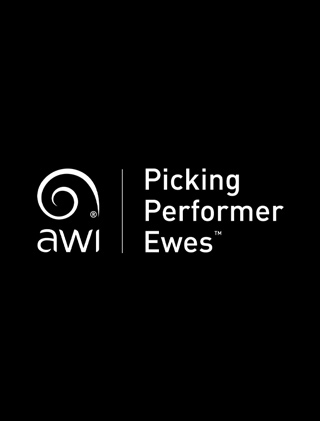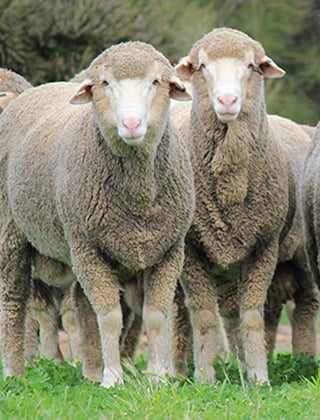A focus on wool-growing set in stone: past, present and future

Reflecting his family’s long history of farming at Highland in central Victoria, fourth generation sheep producer Alistair Lade takes a long-term approach to wool-growing. As well as undertaking exceptional land management and animal welfare practices, Alistair’s focus on technology and genetics has enabled him to select sheep that grow high quality ultrafine Merino wool in a free-range environment.
Woolgrower Alistair Lade at the stone circle comprising six granite obelisks that were erected in 1982 as a tribute to the six original farming families of the Highlands district in central Victoria, one being the Lade family.
Reflecting his family’s long history of farming at Highland in central Victoria, fourth generation sheep producer Alistair Lade takes a long-term approach to wool-growing. As well as undertaking exceptional land management and animal welfare practices, Alistair’s focus on technology and genetics has enabled him to select sheep that grow high quality ultrafine Merino wool in a free-range environment.
On the side of road on the southern end of the Strathbogie Ranges in central Victoria appears a strange but somehow familiar monument. Six granite, human-sized obelisks stand to attention in a circle, a symbol of understated meaning. It is a sight that we associate with the windswept plains of ancient Celtic lands, but the characters in this scene are distinctly local in both geology and genealogy.
The monument stands as a tribute to the six original farming families of the district who came here from those far away wind-swept lands in the 1880s. Four of the six are still farming in the area, one of which is the Lade family who have mastered the difficult job of ultrafine wool-growing. But it has taken four generations, various industry collapses, droughts, disasters, and endless hard work to get there.
The simple but striking monument was an idea sparked by Alistair Lade and is typical of his appreciation of local history, connection to the past as well as a practical-yet-innovative approach to life.
Growing high quality ultrafine Merino wool in a free-range environment is extremely difficult and something very few do well. It requires a focussed long-term dedication to a combination of genetics, nutrition and working in unison with a highly variable climate.
‘Glenrannoch’ is a 1000-hectare property of relatively high rainfall of 800mm. The family has been officially measuring rain since 1915 so the love of measurement comes with the surname. The farm sits 650m above sea level with deep sandy loam soils, cold winters and hot summers with a temperature range between -3 and 40 degrees Celsius: a temperature range where Merino wool has evolved to protect and insulate its wearer; either four legs or two.

Alistair’s Merino sheep grow high quality ultrafine wool in a free-range environment on his ‘Glenrannoch’ property at Highlands.
The property is home to 10,000 Merino sheep, the genetics and production of which have been honed through many generations of painstaking measurement and care. While micron testing individual sheep is popular now, Alistair began doing so back in the 2000s. He secured the services of the latest CSIRO Laserscan technology to help him reduce the average micron of his flock from 19.5 down to 15.5 in just eight years, which was a staggering effort when combined with the consistent staple strength of between 36 and 45 N/Kt. While individually tagging each animal, he could see how some were producing a $30 fleece and others were producing a $150 fleece and both costing the same amount to run. It was a simple but innovative way to increase the productivity of his flock.
“We're shearing 10,000 sheep a year and all our bales, bar one, are under 16 microns, all grown on highly nutritious improved pastures.”
Alistair Lade

Alistair used technology and genetics to reduce the average micron of his flock from 19.5 down to 15.5 in just eight years.
Changing the time of lambing from autumn to spring to better match the animal’s need for energy with the natural production of pasture, and changing the time of shearing from spring to autumn to best support staple strength, are examples of Alistair moving the timing of major farming events. From 2003 to 2006, he placed coats on sheep to best protect the fibre from the elements, but alas the market did not reward this huge effort.
Dedicating so much time to improving the genetics and production of the flock took commitment and faith because, through these years, reward was not always offered to high quality wool production or even wool production for that matter. However, Alistair’s long-term view is to stick to a task and do it well and, with consumer and producer now closer together than ever, the time has come to recognise and reward this going the extra mile.
“With the strain of sheep and consistency of product we've developed, we can as good as say we're going to produce 32,000 tons of certain specifications five years ahead no matter what the climatic conditions, which is surely worth a lot to a processor or a brand that is seeking out quality.”
Alistair Lade
Commitment to a long-term goal is also clear to see on the property itself with the fencing off of 140 hectares of native bush and waterways, protecting riparian zones, fencing to soil type and therefore land use capability, a high-quality timber plantation and clever use of laneways to make movement of stock as efficient as possible. Deep rooting perennial pasture species such as phalaris and cocksfoot combined with rotational grazing makes the best use of rain when it falls and allows for the resting and regeneration of pastures and keeping vegetative cover through dry times. This management also allows for best practice animal health and welfare when it comes to issues such as worm control.
Alistair’s mother, Peg, fostered a love of nature in him and with this has come a lot of native revegetation over the years, often associated with local Landcare programs. More than 130 species of birds are now seen on ‘Glenrannoch’ and, as custodians of the land, each generation of the family hopes to leave the property in a better state than they found it: a very practical measure of sustainability that most farmers use.

Alistair has a keen interest in the end market for wool. He is pictured here with his daughter Isabel (left) in 2019 hosting a delegation from North American brands GAP and Lululemon.
His management of animal welfare and treatments is timely, effective and well documented. All this has been taken into account with the latest management software keeping close records of stock treatments and movements. This is an example of the modern way farming is using traceability, and potentially blockchain into the future, to keep not only keep in touch with but ahead of consumer expectations.
“I am very optimistic about the future of Merino wool given what we have built because wool fits perfectly with what the world wants these days: a natural, renewable, biodegradable fibre simply grown with a combination of these great animals and the sun, earth and water they live with on this farm,” Alistair said.
“I think that there's some really interesting and exciting new wool products on the market – such as next to skin apparel, activewear and casual garments – so I think there's a really good future for wool despite the fact that we've only got a very small proportion of the textile industry.”
Alistair Lade
Having hosted many processors, retailers and brands from Italy, Japan, Korea, Canada and the US over the years, the Lades are well aware of what modern farming requires of them. Alistair has been involved with many farming and research groups that have been connected to supply chains and quality assurance schemes in the past. However, with the digital age now making data flow and transfer so effortless, the dawn has finally arrived on an age where traceability and transparency in production is rewarded by those who benefit from it further along the supply chain.
Alistair and Paula intend to live at ‘Glenrannoch’ for many years to come but are pleased that both son Elliot and daughter Isabel share a deep love of the land and of wool and hope the fifth generation of Lades will take the reins. Either way, the current generation has left a lasting and positive legacy on this very beautiful part of southern Australia, a legacy befitting the simple stone monument that marks their territory here.
More information: Hear more about how Alistair Lade created his ultrafine flock and his approach to marketing his clip in Episode 219 of AWI’s The Yarn podcast available at www.wool.com/podcast
Alistair Lade features in a new marketing campaign titled ‘Merino Wool - Made by Nature’ launched by Italian spinner Zegna Baruffa Lane Borgosesia and The Woolmark Company: Merino Wool Made By Nature.
This article appeared in the September 2022 edition of AWI’s Beyond the Bale magazine. Reproduction of the article is encouraged.















